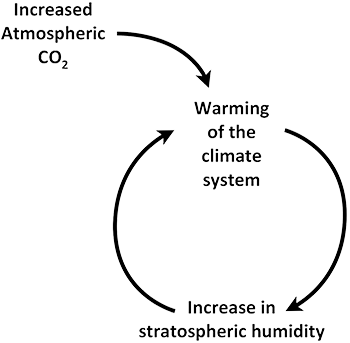A .gov website belongs to an official government organization in the United States.
A lock () or https:// means you've safely connected to the .gov website. Share sensitive information only on official, secure websites.
30 September 2013

A new study shows that water vapor high overhead and the temperature at the Earth's surface are linked in a climate feedback loop – and gives the first estimate of the size of the effect.
"Water vapor in the stratosphere increases in tandem with increases in the Earth's surface temperature," said coauthor Sean Davis, a CIRES scientist at CSD. "Because water vapor is a greenhouse gas, this generates additional warming. We show that this feedback loop could be about 10% of the climate warming from all greenhouse gases."
The new study "Stratospheric water vapor feedback," published online September 30 in the prestigious journal Proceedings of the National Academy of Sciences, quantifies the magnitude of the stratospheric water vapor feedback for the first time, making use of satellite observations and a climate model.
"While it's not really surprising that this process is going on, we were surprised at how important the process is for our climate system," said lead author Andrew Dessler, an atmospheric sciences professor at Texas A&M University and CIRES Visiting Fellow at CSD this summer.
For well over 100 years it has been known that increased emissions of greenhouse gases such as carbon dioxide will warm the planet. As the lowest layer of the atmosphere, called the troposphere (surface to ~7 miles), is warmed, the air becomes more humid, because warmer air holds more water vapor. This "tropospheric water vapor feedback" approximately doubles the initial warming caused by carbon dioxide.
The new results suggest that the stratospheric water vapor feedback may be an important component of our climate system. The researchers estimated that at a minimum this feedback adds another ~5-10% to the climate warming from the addition of greenhouse gases, and is possibly substantially more than this amount.
Most climate models contain a representation of stratospheric water vapor, so this feedback is already operating in the models to some extent. Thus, this new finding does not necessarily mean that models have underestimated future global warming. However, since the importance of this feedback has not been previously recognized, it is possible that the stratospheric water vapor feedback may help to explain some of the spread among future projections of climate change from different models. Indeed, of the ~20 models participating in the 5th Assessment report of the Intergovernmental Panel on Climate Change (IPCC), the authors found substantial differences among the models' future simulation of stratospheric water vapor.
Though the study has moved understanding an important step forward, many questions remain about the role of stratospheric water vapor in climate.
"The stratospheric water vapor feedback effect could be even larger than the 5-10% we found in our study," said Davis. "Our analysis suggests that the pathways for water vapor to reach the stratosphere are not completely understood, so we view our numbers as a minimum estimate of the effect of this feedback."
The authors of the study are Andrew Dessler and Tao Wang (Texas A&M University), Mark Schoeberl (Science and Technology Corporation), Sean Davis (CIRES and NOAA ESRL CSD), and Karen Rosenlof (NOAA ESRL CSD).
A.E. Dessler, M.R. Schoeberl, T. Wang, S.M. Davis and K.H. Rosenlof, Stratospheric water vapor feedback, Proceedings of the National Academy of Sciences, doi:10.1073/pnas.1310344110, 2013.
We show here that stratospheric water vapor variations play an important role in the evolution of our climate. This comes from analysis of observations showing that stratospheric water vapor increases with tropospheric temperature, implying the existence of a stratospheric water vapor feedback. We estimate the strength of this feedback in a chemistry-climate model to be +0.3 W/(m2⋅K), which would be a significant contributor to the overall climate sensitivity. One-third of this feedback comes from increases in water vapor entering the stratosphere through the tropical tropopause layer, with the rest coming from increases in water vapor entering through the extratropical tropopause.